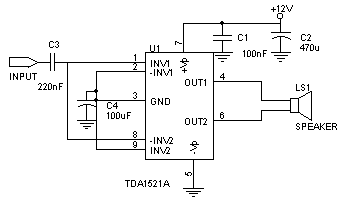MyFirstAmplifier
It's almost a rite-of-passage, all electronics engineers worth their salt have to prove themselves by building a power amplifier... so here was my shabby attempt, not a grand discrete design, but based on a puny TDA1521 TV Amplifier chip.
Overview
The circuit is from an old Philips promotional article I found, on their "new" BTL amplifiers. I've lost the original article and I cannibalized the circuit board for the capacitors, so the circuit shown below is a guess. PLEASE DO NOT ATTEMPT TO BUILD IT UNLESS YOU KNOW IT IS RIGHT!

MyFirstAmplifier!
Simple, isn't it? That's what I thought when I built it. The soldering was quite shabby, and the whole thing fit onto a tiny piece of veroboard. I used it to provide a "subwoofer" for my computer's soundcard, by attaching this circuit (no LPF!!!) to the output, and driving an old 9" driver I had lying around (Thanks Kazi!) I used a rather large aluminium heatsink, but it was attached rather poorly. I didnt think much of it, because the IC barely got warm. All was fine until one day my dad bought a new car stereo system, with some juicy-looking Pioneer polycarbonate-cone drivers. These being car-audio drivers, had 4Ω coils, while my old woofer had a 10Ω coil. Without realizing this, I hooked up one of the Pioneer drivers and turned the volume all the way up, while playing some trance music (why? I wanted to see the cone bouncing around!) I was thoroughly enjoying myself when suddenly, I heard a BANG! My first thought was the drivers went bust, in which case I would be bust, too! That's when I saw the Rs. 75 amp chip (big money for me) with the top half of the plastic case cleanly blown off! I've never poorly heat-sinked any device after that!
I've now made another power amp, based on the LM4753 from National. It's not bad, 10W stereo and a DC volume control, meaning no need for expensive log-taper stereo pots. I will post the schematics soon, but it's straight out of the datasheets.
Disclaimer
These circuits are provided for your own study only. They all deal with electricity and electronics, a sufficient knowledge of both is assumed. I will not take any responsibility for any personal injury or damage to property arising from use or abuse of the information provided on these pages.
